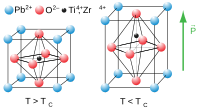
Photo from wikipedia
Structure and electrical properties of Mn-doped (0.6 − x)Pb(Mg1/3Ta2/3)O3–xPbZrO3(PZ)–0.4PbTiO3 (PMT–PZ–PT) ceramics with morphotropic phase boundary were studied (x = 0.2 and 0.25). The tetragonal intensity ratio TP (%) of Mn doped 0.4PMT–0.2PZ–0.4PT samples was… Click to show full abstract
Structure and electrical properties of Mn-doped (0.6 − x)Pb(Mg1/3Ta2/3)O3–xPbZrO3(PZ)–0.4PbTiO3 (PMT–PZ–PT) ceramics with morphotropic phase boundary were studied (x = 0.2 and 0.25). The tetragonal intensity ratio TP (%) of Mn doped 0.4PMT–0.2PZ–0.4PT samples was calculated based on Raman spectra. The TP (%) values were found to increase with MnO2 doping, being from 67.6 to 78.3%, then decrease sharply at the doping limit of 0.8 wt%. The X-ray diffraction (XRD) pattern of Mn 0.2 wt% doped 0.35PMT–0.25PZ–0.4PT sample indicates the existence of more tetragonal phase at room temperature, where the XRD peaks become broader over temperature range of 90–160 °C, induced by the rhombohedral to tetragonal phase transition. The remnant polarization (Pr) was found to increase with increasing Mn doped level, while the coercive field shown contrary trend. Due to the “hardening” effect caused by the Mn addition (acceptor dopant), the dielectric constant and dielectric loss of 0.35PMT–0.25PZ–0.4PT ceramics were found decreased, while the mechanical quality factors were found increased up to 790. Of particular interest is that the piezoelectric coefficient (d33 ~ 435pC/N) and electromechanical coupling factors (kp = 59%) were found to increase with Mn addition, showing a “softening” effect, due to the existence of oxygen vacancies, which may improve the sinterability of the ceramics at high temperature.
Journal Title: Journal of Materials Science: Materials in Electronics
Year Published: 2018
Link to full text (if available)
Share on Social Media: Sign Up to like & get
recommendations!